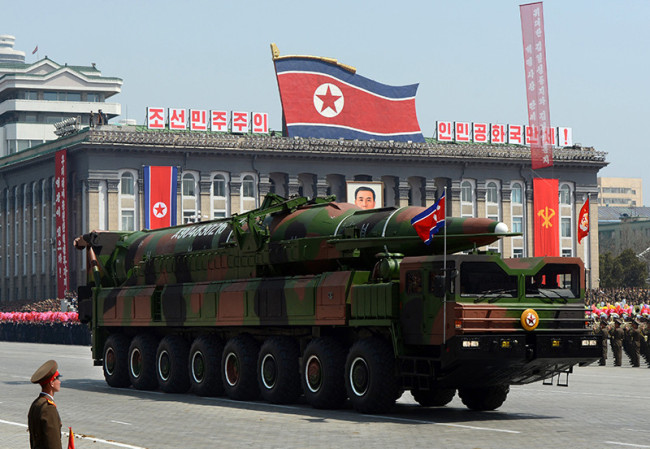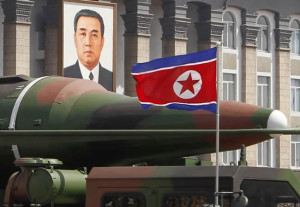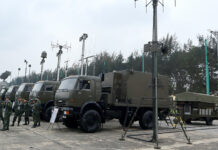

The KN-08 missile (also known locally as ‘Hwaseong 13’) was unveiled on a military march in Pyongyang April 15, 2012. This new missile was part of a massive display of ballistic missiles developed and built in the DPRK.
But the new missile was different from other missiles on the march. The three-stage, liquid fueled propulsion system was different from those seen on previous missiles displayed by the North. Based on photo-analysis measurements and assumptions, this missile has a takeoff weight of 45 tons, and capable of a ballistic flight over a distance of 7,500 km. To mobilize such a weapon North Korea ordered a special 16 wheel (8 axles) carrier designed and built in China. This vehicle is configured as a mobile Transporter-Erector-Launcher (TEL) platform, designed to carry the monster missile from its hideouts caves or underground tunnels, travel over open terrain (avoiding roads vulnerable to enemy attack) to pre-designated launch sites. To minimize the exposure of the TEL to enemy strikes, the KN-08 is likely to be fueled in its storage sites, and move on wheels to the launch site. An indication to such practice is the design of the Chinese WS51200 vehicle used for the TEL, featuring six powered axles out of the total eight, designed to support the much heavier fuelled missile.
Update: While some analysts criticized the missile as a fake, the pentagon and US administration is taking the North Korean threat very seriously. Less than a year after the public exposure of the missile, the US has revamped its defensive and offensive posture in the Pacific, bolstering the missile defense radars based in Japan, deploying multiple AEGIS cruisers and destroyers, equipped with SM-3 Block IA interceptors in the Western Pacific and adding 14 new Ground Based Interceptors to the missile defense site in Alaska.
The three stages of the KN-08 operate with liquid rocket propulsion and have finless configuration. The total length is over 18 meters (7.2, 5 and 3 meters respectively), and the diameter of the first stage is about two meters, while the second stage is about 1.4 meters. The third stage, carrying the flight instruments section and reentry vehicle has a diameter of about 1.25 meters. The weight of the reentry vehicle is estimated at 0.7 tons.
Attitude control is achieved by four vernier thrusters attached to the first, second and third stages. These auxiliary thrusters are likely to be derivatives of Musudan (BM25) open-cycle turbo-machinery system.
While North Korea has not tested the full scale KN-08 missile, analysts believe part of the KN-08 propulsion systems have been matured through recent engine, stage systems and dynamic testing of flight hardware were focused on improving the closed cycle propulsion performance of the engines. At least four such tests reportedly took place in Musudan-ri missile test range In 2011 and early 2012. According to sources in Seoul, at least two of these tests failed.

Israeli analysts consider the propulsion system used for the KN-08 missile is unsymmetrical dimethylhydrazine (UDMH) and nitrogen tetroxide as oxidizer (N2O4). ה The payload of both warheads is believed to be a nuclear warhead. The use of such propulsion system was a must given Pyongyang’s ambitions to extend the range of their ballistic missiles. Would they remain with the fuel used with their No Dong missiles, the range of the new missile would be slashed by half. With that range, Pyongyang can keep at risk US targets in the Pacific, including Guam and Hawaii, as well as Alaska and Seattle, in Washington State. In recent years the US Missile defense Agency (MDA) deployed Ground Based Interceptor (GBI) missiles in Fort Greely, Alaska and Vandenberg AFB in California, to protect against such potential threats. Pyongyang is believed to be on the way to develop missiles with even longer range, up to 12,000 km, reaching the East Coast. To face such future threat the Pentagon is seeking to deploy at least two GBI sites on the East Coast of the USA.
The KN-08, Semi-Mobile, Limited Range-ICBM (LR-ICBM) system that have evolved over the previous North Korean five year plan was closely watched by the US intelligence community. Cables leaked by Wikileaks mention the new missile since 2009. Former Secretary of Defense, Dr. Robert M. Gates addressed the evolving threat in his visit in Beijing in 2010, when it became evident that the Chinese assisted the North Korean program, at least by providing highly specialized vehicle for the TEL.
Although the KN-08 LR-ICBM has not been flown yet, the system has undergone Research & Development, dynamic and rocket propulsion system static test firing. Some of the technology used for the propulsion system could also be acquired from abroad, namely experts in China, Russia or Ukraine. These were necessary stages before flight test of the KN-08 commences within this 2011-2015 Five Year Plan.
While the missiles on parade were most likely models or mockups of the real missiles, the investment in multiple, standardized, large scale, highly detailed and realistic mockups and the TELs that came with them indicate the North Koreans have plans to use such assets in operational development and evaluation and training for an operational formation of these strategic rocket force, probably a brigade-level force. It can also provide for training pre-launch drills, including ground movement, missile erection, fueling and defueling procedures.
















